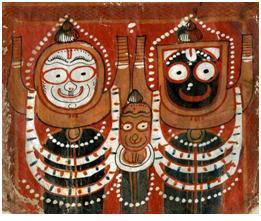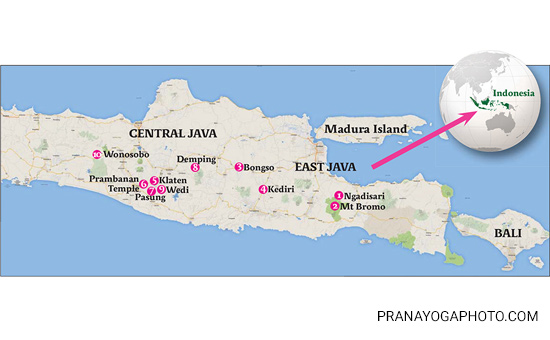In a previous article titled “The Opet Festival of Ancient Egypt: Has it been derived from the Jagannatha Rathyatra of Puri, India?” I had pointed out the many similarities between Amun, the all-powerful Creator god of the ancient Egyptians (with his primary center of worship at Thebes), and Krishna, the Supreme Creator of the Vedic Indians. Both of them were blue-complexioned, wore “feathers in their head-dress” and were depicted with a “sacred river” emerging from their feet. In addition, the grand Opet festival of the ancient Egyptians, which was celebrated over a period of 24-27 days during the season of the flooding of the Nile, is identical in form and spirit to the Jagannath Rathyatra festival that is still celebrated every year at the tiny coastal town of Puri, India. The worship of Krishna (or Jagannath) and the observance of the Rathyatra festival are quintessentially Vedic festivals, which have been observed for thousands of years prior to the establishment of the cult of Amun at Thebes (as per the information contained in many Sanskrit texts). This implies that the Vedic triad of divinities – Krishna, Balarama and Subhadra – must have been transferred from India to Egypt sometime prior to the beginning of the New Kingdom in c. 1550 BC.
On further investigation I found many more similarities between these two ancient deities – Amun and Krishna. A number of hymns from the ancient Coffin Texts of Egypt associate Amun with the falcon-headed god Horus, while in Hindu myths Krishna is associated with the eagle-headed deity Garuda, who acts as his vahana i.e. carrier. Even the etymology of the name Amun has close associations with Krishna. In Egyptian, Amun is written as Ymn, which has been reconstructed by Egyptologists to “Yamanu”, and sometimes also spelled as “Yamun”. “Yamanu” or “Yamun” is very closely related to the sacred river “Yamuna” in India, which is intimately tied up with the childhood of Krishna, who grew up on the banks of the river Yamuna. The waters of the Yamuna are of a dark-blue color, which has been likened to the complexion of Krishna, and the river is regarded as the source of love, compassion and spiritual capabilities. It is possible that the Egyptian Ymn may actually be a reference to the Yamuna, which became shortened to Yamun, and subsequently to Amun.
Even at a metaphysical level, Amun and Krishna are very similar. Amun was regarded as the “hidden one”, and the epithet, "he whose name is hidden", was frequently applied to him. Amun’s form was “unknown”, and it was said that no-one could behold or understand him, except Amun himself. The Boulaq Papyrus from the XVIII Dynasty (1552-1295 BC) describes Amun as the “Greatest in Heaven…Lord of all, who is in all things.” Amun abides in all; everything happens in him, and nothing exists outside him. He is the Supreme Creator: “The One maker of all things, Creator and Maker of beings, From Whose eyes mankind proceeded, From Whose mouth the Gods were created.” He was, “The One Whose forms are greater than every God, In Whose Beauty the Gods jubilate.” Amun was also the “champion of the poor” and he became the “personal savior” of anyone who took him into his heart.
“[Amun] who comes at the voice of the poor in distress, who gives breath to him who is wretched…You are Amun, the Lord of the silent, who comes at the voice of the poor; when I call to you in my distress You come and rescue me.”
The same epithets are also associated with Krishna. Krishna is “karuna seendhu” (sea of compassion) and “deena bandhu” (the friend of the poor), who responds to a devotee’s call instantly, as exemplified in the Mahabharata, when he was invoked by Draupadi. In the Bhagavad Gita, Krishna asks Arjuna to regard him as his only protector, for, he says, “Remembering me, you shall overcome all difficulties through my grace.” Krishna, like Amun, abides in the heart of all creatures as the indestructible “Self”, and his “unknowable form” pervades the entire cosmos. The birth and dissolution of the cosmos itself take place in Krishna: “There is nothing that exists separate from me, Arjuna. The entire universe is suspended from me as my necklace of jewels” . Although, Krishna remains unknowable and invisible, the multifarious celestial beings of this created world reflect his various divine attributes: “Wherever you find strength, or beauty, or spiritual power, you may be sure that these have sprung from a spark of my essence.” Yet, no-one could understand the real nature of Krishna, for Arjuna tells Krishna, “Neither gods nor demons know your real nature. Indeed, you alone know yourself, O Supreme Spirit.” This is similar to the Egyptian texts which assert that no-one could behold or understand Amun, except Amun himself. Krishna further confirms this: “I know everything about the past, the present, and the future, Arjuna; but there is no one who knows me completely” .
In fact, the entire Theban triad of Amun, Mut and Khonsu, are related to the triad of divinities – Krishna, Balaram and Subhadra - worshipped at the Jagannath temple at Puri, India. Krishna’s brother, the fair-skinned Balaram, is considered to be an incarnation of “Ananta-Sesha” - the primeval serpent of the abyss, in whose coils Vishnu rests in the middle of the cosmic Milky Ocean. Ananta-Sesha is himself a powerful agent of creation, and he co-exists with Vishnu at the beginning and end of the creative cycle. We find the same imagery associated with Khonsu, the son of Amun. On one of the walls at Karnak, a cosmogony is depicted in which Khonsu is described as the “Great Snake who fertilizes the Cosmic Egg in the creation of the world” (Wikipedia). In addition, Mut (who is believed to have been the wife of Amun), and Subhadra, the sister of Krishna, were both regarded as manifestations of the great mother goddess.
|
|

|  |
| Fig 1: Krishna, Balaram and Subhadra - The Puri Triad. Subhadra is in the center, flanked by the dark-complexcioned Krishna and the fair-complexioned Balarama, on either side. Source: Wikipedia. |
Fig 2: Amun, Mut and Khonsu- The Theban Triad. Khonsu is in the center, flanked by the dark-complexioned Amun and the fair-complexioned Mut. Source: www.kenseamedia.com |
But the question is how did an entire pantheon of deities, along with associated ceremonies, rites and rituals migrate from India to Egypt, at a time when the existing pantheon and religious beliefs of the Egyptians was already well formulated? What historical events could have led to this?
In order to understand this sudden influx of Vedic beliefs into the religious practices of the ancient Egyptians, it is important to recount a critical event that took place before the beginning of the New Kingdom in Egypt i.e. prior to 1550 BC. Sometime during 1700 BC, Egypt had been overrun by a group of irreligious, nomadic invaders known as the Hyskos (which means “rulers of foreign countries”). The term was chiefly used during the Middle Kingdom to refer to the nomadic Semitic tribes of Canaan and Syria. As per the Egyptian accounts, the Hyskos had burnt the Egyptian cities to the ground, destroyed all their temples and had led their women and children into slavery. This was a time of great suffering for the Egyptian people. During this time, the Egyptian pharaohs had been forced to retreat south, driven into the neighbouring kingdom of Kush (Nubia), which was also referred to as “Ethiopia” by the classical Greek historians (although this region now falls within the boundaries of modern Sudan). The pharaoh Ahmose secured the favor of the Kushites by marrying Nefertari, the black princess of Ethiopia. She was of a very dark complexion, and was the most venerated woman in all of Egyptian history. Egyptologist George Rawlinson, in his book Ancient Egypt, says about King Ahmose (referred to as Aahmes):
“He married a princess, who took on the name of Nefet-ari-Aahmes, or “the beautiful companion of Aahmes,” and who is represented on the monuments with pleasing features, but a complexion of ebon blackness. It is certainly wrong to call her a “negress;” she was an Ethiopian of the best physical type; and her marriage with Aahmes may have been based upon a political motive. The Egyptian Pharaohs from time to time allied themselves with the monarchs of the south, partly to obtain the aid of Ethiopian troops in their wars, partly with a view of claiming, in the right of their wives, dominion over the Upper Nile region. Aahmes may have been the first to do this; or he may simply have followed the example of his predecessors, who, forced by the Hyksos to the south, had contracted marriages with the families of Ethiopian rulers.”
Armed with the financial and military help of the Kushites, the Hyskos invaders of Egypt were finally evicted from the country after 200 years of occupation. During this time, the pharaohs Kamose and Ahmose had fought under the banner of their new-found god: Amun. This event, which took place at around 1550 BC, signified the beginning of the 18th dynasty, which is acknowledged as the greatest royal family of Egypt. Ahmose became the first pharaoh of the 18th dynasty. Amun became the supreme protector god of the monarchy and the state, and his priesthood gained immense power. Magnificent temple complexes dedicated to Amun were established in Karnak. Since Amun came to the aid of the Egyptian people at the time of their greatest distress and ignominy, his cult became all powerful, and dwarfed all the other gods and goddesses of the Egyptian pantheon.
This historical event indicates that the worship of Amun must have passed on to Egypt from the ancient Kushites of Ethiopia. The 18th dynasty pharaohs continued to maintain strong matrimonial connections with their Kushite neighbours, and Kushite priests held sway at the temple complex at Karnak. But if that were the case, then how did the worship of Jagannath make its way to ancient Kush from India?
 |
Fig 3: Map of Africa in 400 BC, showing the kingdom of Kush and its neighbouring countries. The river Nile flows through Kush and Egypt. Kush was also known as Nubia (The Land of Gold). |